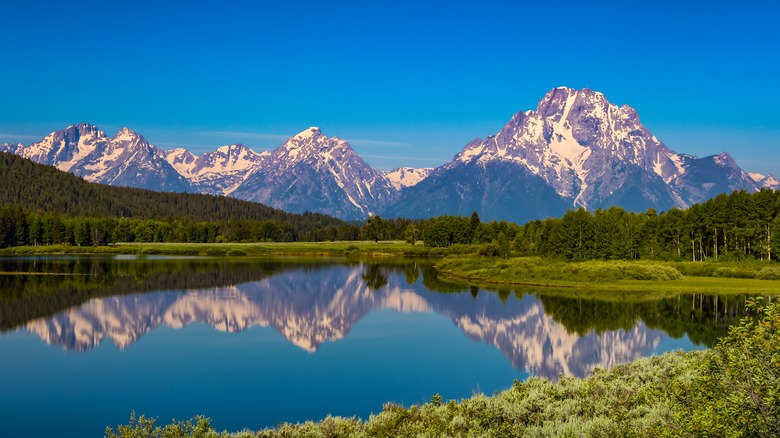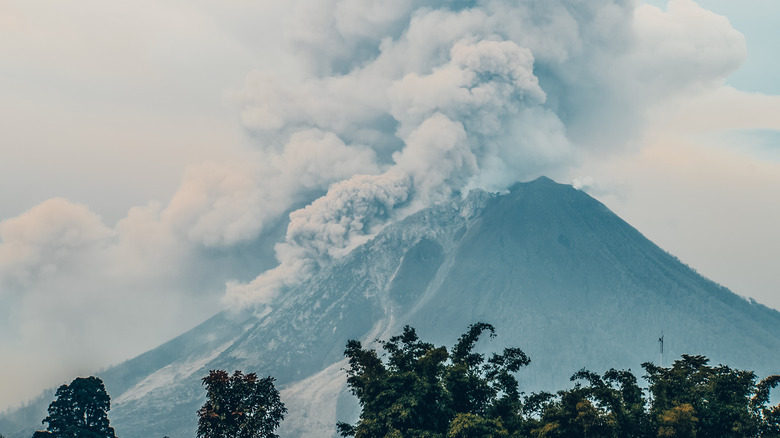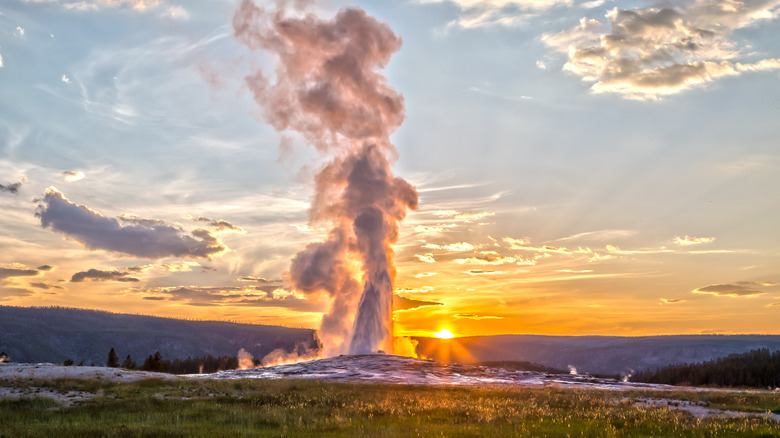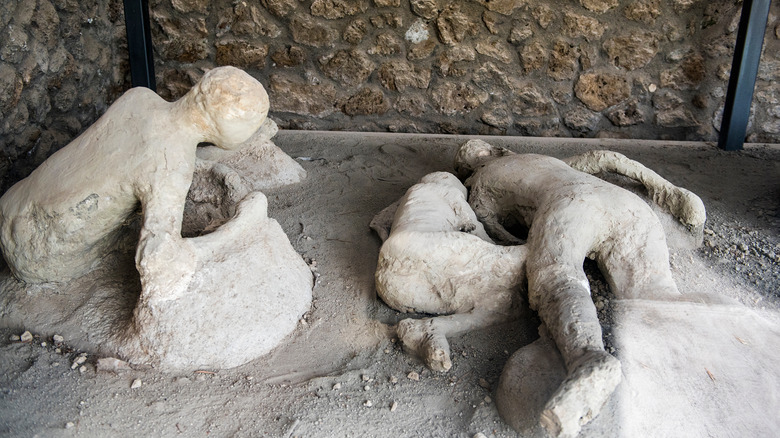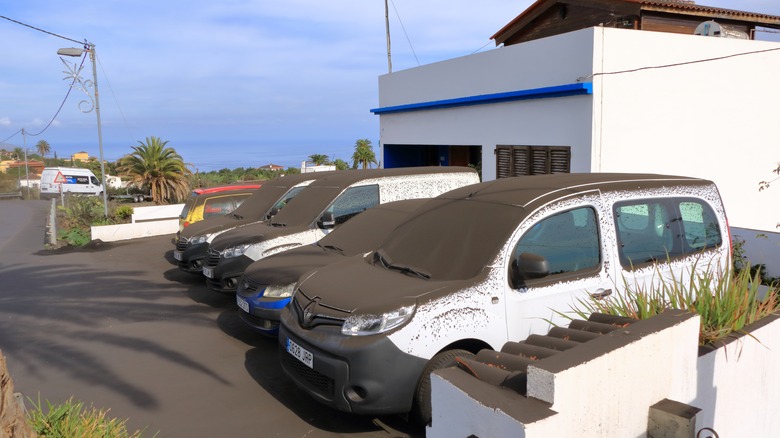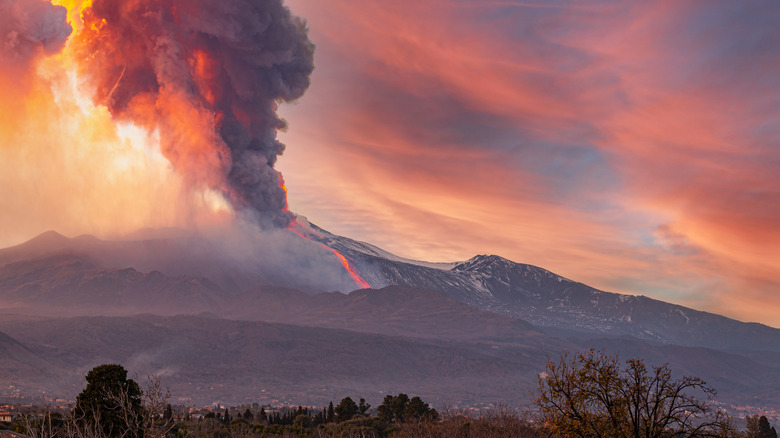How Yellowstone National Park Could End All Life As We Know It
Among America's national parks, none has quite the reputation for beauty and diversity that Yellowstone does. It's a testament to a land untouched by human hands, sculpted only by the delicate touch of nature and time.
Its natural diversity is unrivaled in the continental U.S. In addition to the hundreds of bird species that call Yellowstone home, it's the abode of more mammal species than anywhere else in the lower 48 (via U.S. Department of the Interior). And it's not just the unique ecology that makes Yellowstone special — it has a geology unlike anywhere else in the world. It has so many geothermal features that nowhere else on the planet comes close to comparing (via US-Parks.com), and powering these geysers and hot springs deep beneath the park is a vast reservoir of magma and water (via Eos).
Although Yellowstone is known as an idyllic place today, it has been the site of some of the largest volcanic eruptions in history. Yellowstone doesn't just sit on top of a geologic hotspot — it straddles one of the most powerful supervolcanoes ever discovered (via National Park Service).
What's a supervolcano?
Strictly speaking, a supervolcano is any volcano that has had at least one eruption that has registered as an 8 on the Volcanic Explosivity Index (via U.S. Geological Survey). The VEI is a measure of how powerful a volcanic eruption is. Think of it like the Richter scale for earthquakes in that each number indicates a tenfold increase in intensity (via NPS).
The 1980 Mount St. Helens eruption barely registered as a 5 on the scale. That eruption obliterated the face of the mountain, sent an ash cloud 80,000 feet high, and ravaged the local ecosystem (via U.S. Forest Service). Somewhere in the 6 range is the Tonga eruption from earlier this year (via Cosmos), which could be heard as far away as Alaska.
The Krakatoa volcano in Indonesia is the modern benchmark by which powerful volcanoes are measured. It erupted with an explosive force 10,000 times more powerful than the first atomic bombs, launching 6 cubic miles of debris into the air and temporarily cooling the global climate for years. Krakatoa rated as a 6 on the VEI (via History).
To register as an 8, a volcano needs to eject over 200 cubic miles of debris and produce an ash cloud that rises over 16 miles into the atmosphere. For comparison, that's enough ejecta to cover an area four times the size of Texas in a foot of debris and an ash cloud twice as high as airplanes fly.
What happens when Yellowstone erupts?
America's first national park is actually erupting all the time. The last one of note, a hydrothermal explosion, happened in 1989 and launched rocks up to 15 feet. These types of explosions can create craters nearly a mile wide (via USGS).
The last time lava flowed in Yellowstone was 70,000 years ago. A similar event today would cause problems, but likely not on a national scale as all the damage would be localized. Although the devastation caused by a lava flow would be restricted in scope, the flow itself is an unstoppable force. It will bury or burn everything in its path and leave only smoldering rocks in its wake (via USGS). Thankfully, Yellowstone is sparsely populated, and lava moves slowly, making any evacuations easier.
A supervolcano eruption (the last one at Yellowstone was over 600,000 years ago) would literally change the world. The park itself would likely be buried in lava flows. Much of the United States would be covered in a blanket of ash, from a few inches deep in the Midwest to more than a foot in the states surrounding Yellowstone. Globally, temperatures will drop and won't recover for years, maybe even decades. How bad will it be? Let's break it down (via Vox).
Ashfall
Volcanic ash will be the most pressing problem in the days and weeks following an eruption. The ash we're most familiar with is made from burning wood, which is soft, light, and made from organic matter. Volcanic ash is a different beast. It's created from the explosive force of the volcano shattering rocks and launching magma into the air, and it's made of jagged, minuscule bits of rock and volcanic glass (via Discover). When these rock and glass particles are inhaled, the health effects can range from mild discomfort to chronic disease. In the short term, you can expect difficulty breathing because your lungs are being coated with rocks and glass. The worst health outcome is silicosis — when volcanic crystals scar the lining of the lungs, leaving them permanently damaged. (via Bulletin of Volcanology).
Did we mention the eyes? It turns out that having glass dust in your eyes is bad for them, causing scratches on the cornea. Thankfully, these respiratory and ocular threats can be mitigated by wearing a proper facemask and goggles (via USGS).
Infrastructure
But it gets worse. Volcanic ash is conductive, and as it falls on power lines, it can cause short circuits across insulators, potentially damaging the power network. The weight of the ash on the lines can also cause problems by bringing power lines down (via Physics and Chemistry of the Earth, Parts A/B/C). And when the ashfall gets into the water, it causes even more trouble, damaging dam turbines and disrupting the water supply systems in general. Just six months of exposure to volcanic ash in the water can cause up to 16 years of weathering.
Now that you can't breathe, there's no power and no water, you should just leave, right? Good luck with that. The same factors that make ash so destructive to machinery also make it destructive to anything with moving parts. The ash will get under your hood, thicken your oil, block your filters, clog your brakes, and permanently damage your windshield. This same damage will happen to every emergency vehicle, limiting any coordinated response.
You know what else has moving parts? Airplanes. Air Travel across the continental U.S. will be shut down temporarily, just like the Eyjafjallajökull volcano shut down large swathes of European airspace in 2010. That eruption rated as a 4 on the VEI and disrupted over 100,000 flights over eight days, costing $4.7 billion in lost GDP (via The Student Economic Review). A Yellowstone eruption would be orders of magnitude worse.
Volcanic winter
Much like a bottle of soda, magma is loaded with dissolved gasses. When that magma reaches the surface, those gasses are released in a dramatic fashion, sometimes resulting in massive explosions. One of those gasses is sulfur dioxide, which gets converted to sulfuric acid in the atmosphere. It's then suspended in the air as an aerosol and reflects solar light back out into space, lowering the temperature of the planet (via USGS).
When Mt. Pinatubo erupted in 1991, the global temperature dropped 1 degree over the following year (via NASA). The Tambora eruption of 1815 produced similar cooling and induced a year without summer the following year. These events released 15 to 20 million tons of sulfur dioxide into the air. A supereruption at Yellowstone would release about 100 times as much and cool the planet by up to 16 degrees. A climactic change of this magnitude would wreak havoc with the world's weather. Similar, smaller events in the past have led to famine and drought (via Communications Earth & Environment).
Thankfully, we won't have to worry about this any time soon. We know of three past eruptions, and if we go by the average interval between eruptions, we still have about 100,000 years to go before we're due for another one. And scientists think, based on magma levels, that another one might not even be possible (via USGS).
